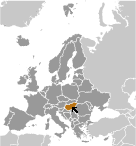World Atlas: Hungary. On this page you can see the map, country flag and many detailed information about the people, history and economy of Hungary.

Here you can find online selected information about the geography, inhabitants, government, economy and history of Hungary. Included are selected statistics, an overview map and the detailed map of Hungary. But let's start with the flag of Hungary here:
Hungary - Overview:
What you should know about Hungary? Let's start with this: Hungary became a Christian kingdom in A.D. 1000 and for many centuries served as a bulwark against Ottoman Turkish expansion in Europe. The kingdom eventually became part of the polyglot Austro-Hungarian Empire, which collapsed during World War I. The country fell under communist rule following World War II. In 1956, a revolt and an announced withdrawal from the Warsaw Pact were met with a massive military intervention by Moscow. Under the leadership of Janos Kadar in 1968, Hungary began liberalizing its economy, introducing so-called "Goulash Communism." Hungary held its first multiparty elections in 1990 and initiated a free market economy. It joined NATO in 1999 and the EU five years later.
Geography of Hungary
 Where on the globe is Hungary? The location of this country is Central Europe, northwest of Romania. Total area of Hungary is 93,028 sq km, of which 89,608 sq km is land. So this is not a large country. How could we describe the terrain of the country? This way: mostly flat to rolling plains; hills and low mountains on the Slovakian borde. The lowest point of Hungary is Tisza River 78 m, the highest point Kekes 1,014 m. And the climate is temperate; cold, cloudy, humid winters; warm summers.
Where on the globe is Hungary? The location of this country is Central Europe, northwest of Romania. Total area of Hungary is 93,028 sq km, of which 89,608 sq km is land. So this is not a large country. How could we describe the terrain of the country? This way: mostly flat to rolling plains; hills and low mountains on the Slovakian borde. The lowest point of Hungary is Tisza River 78 m, the highest point Kekes 1,014 m. And the climate is temperate; cold, cloudy, humid winters; warm summers.
Inhabitants of Hungary
Let's take a look how many people live in Hungary. The number is: 9,850,845 (July 2017 est.). So this is not very populous country. Who lives here? Hungarian 85.6%, Romani 3.2%, German 1.9%, other 2.6%, unspecified 14.1% (2011 est.). What are the languages in Hungary? Hungarian (official) 99.6%, English 16%, German 11.2%, Russian 1.6%, Romanian 1.3%, French 1.2%, other 4.2%. And the religions: Roman Catholic 37.2%, Calvinist 11.6%, Lutheran 2.2%, Greek Catholic 1.8%, other 1.9%, none 18.2%, unspecified 27.2% (2011 est.). How old are the people in average? 42.3 years. We have to add that this number is the median - so one half of the people is older than this, one half is younger. And what is their life expectancy (at birth)? This: 76.1 years. Where the people live in Hungary? Here: a fairly even distribution throughout most of the country, with urban areas attracting larger and denser populations. The major urban areas of Hungary are: Budapest (capital) 1.714 million (2015).
Government and Economy of Hungary
The capital of Hungary is Budapest and the government type parliamentary republic. Let's take a look at the administrative divisions - 19 counties (megyek, singular - megye), 23 cities with county rights (megyei jogu varosok, singular - megyei jogu varos), and 1 capital city (fovaros). Regarding the economy of Hungary, important industrial products are mining, metallurgy, construction materials, processed foods, textiles, chemicals (especially pharmaceuticals), motor vehicles. Important agricultural products are wheat, corn, sunflower seed, potatoes, sugar beets; pigs, cattle, poultry, dairy products. The most important export commodities are machinery and equipment 53.4%, other manufactures 31.2%, food products 8.4%, raw materials 3.4%, fuels and electricity 3.9% (2012 est.) and the most important export partners are Germany 28.2%, Romania 5.2%, Slovakia 5%, Austria 4.9%, France 4.8%, Italy 4.8%, Czech Republic 4.2%, Poland 4.2% (2016). The most important import commodities are machinery and equipment 45.4%, other manufactures 34.3%, fuels and electricity 12.6%, food products 5.3%, raw materials 2.5% (2012) and the most important import partners are Germany 26.3%, Austria 6.4%, China 6.3%, Poland 5.5%, Slovakia 5.3%, Netherlands 4.9%, Czech Republic 4.9%, France 4.8%, Italy 4.8% (2016). How rich is Hungary and how rich are people in this country? The most important number here is GDP per capita (PPP): $28,900 (2017 est.). This means the living standards are good here. Let's add that this means Gross Domestic Product per person, which is recalculated with respect to the relative cost of local goods and services. And one more important number - population below poverty line: 14.9% (2015 est.).